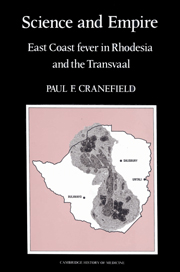Book contents
- Frontmatter
- Contents
- List of illustrations
- Preface
- Acknowledgments
- 1 Prologue
- 2 The places and the players
- 3 A new disease?
- 4 The search for an expert
- 5 Robert Koch in Bulawayo
- 6 Joseph Chamberlain
- 7 Arnold Theiler, Charles Lounsbury and Duncan Hutcheon
- 8 The fight against East Coast fever
- 9 The African-owned cattle in Rhodesia
- 10 Two more parasites and another new disease
- 11 What is East Coast fever?
- 12 Epilogue
- Notes and references
- Index
10 - Two more parasites and another new disease
Published online by Cambridge University Press: 19 January 2010
- Frontmatter
- Contents
- List of illustrations
- Preface
- Acknowledgments
- 1 Prologue
- 2 The places and the players
- 3 A new disease?
- 4 The search for an expert
- 5 Robert Koch in Bulawayo
- 6 Joseph Chamberlain
- 7 Arnold Theiler, Charles Lounsbury and Duncan Hutcheon
- 8 The fight against East Coast fever
- 9 The African-owned cattle in Rhodesia
- 10 Two more parasites and another new disease
- 11 What is East Coast fever?
- 12 Epilogue
- Notes and references
- Index
Summary
The rod-shaped parasite that causes East Coast fever is not the juvenile form of the pear-shaped parasite that causes Texas fever. That much had been established by 1904. But a good deal of confusion remained about some rod-shaped and ring-shaped parasites, often seen in the blood of animals that had been inoculated in an attempt to immunize them against East Coast fever. Moreover, the tiny cocci that Smith and Kilborne had seen in mild cases of Texas fever also remained unexplained as of 1904: unexplained in the sense that no one had questioned the original conclusion of Smith and Kilborne that those tiny cocci were the juvenile form of the pear-shaped parasite.
The second new parasite: Theileria mutans
Koch, in his efforts to devise a vaccine, had injected blood into non-immune animals. A few weeks after such injections he regularly found what he called “ring forms” in the “immunized” animals. He took the presence of those ring forms to indicate that the animals had indeed been immunized against East Coast fever. At the Bloemfontein conference of December, 1903, Theiler, apparently referring to the ring form, said that “He believed it to be a new species of piroplasma and that it had nothing to do with East Coast Fever.” In 1904 Theiler returned to the problem in his article “The Piroplasma bigeminum of the immune ox.”
- Type
- Chapter
- Information
- Science and EmpireEast Coast Fever in Rhodesia and the Transvaal, pp. 239 - 257Publisher: Cambridge University PressPrint publication year: 1991



